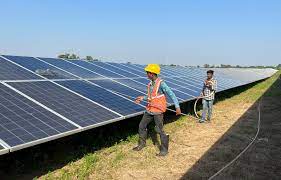15 May 2024 , 12:59 PM
For the first time since the 1960s, coal’s percentage of India’s overall power generation capacity fell below 50% in the first quarter of 2024. According to the Institute for Energy Economics and Financial Analysis’s (IEEFA) most recent POWERup quarterly report, renewable energy contributed 71.5% of India’s record 13,669 megawatts (MW) of new power generation capacity added in the first quarter of this year (January–March).
For the first time since the 1960s, the proportion of coal, including lignite, in India’s overall power generation capacity fell below 50%.
The trend towards renewable energy is well ahead of India’s goal of attaining 50% of its total power generation capacity from non-fossil fuel-based sources by 2030, according to the research.
The reduction in the proportion of coal used in power generation capacity is consistent with a worldwide trend; in 2023, the demand for coal in the G7 countries fell to historic lows not seen since 1900.
In an effort to expedite the shift, the G7 nations extended their earlier promise to stop building any new coal-fired power plants by 2035 and committed to phase out all unabated coal power output by that time.
In general, “unabated” refers to the usage of coal, oil, and gas without any attempts to reduce emissions.
World leaders came to a historic agreement in December of last year at the United Nations’ COP28 climate change summit to shift away from fossil fuels that overheat the globe and quadruple the amount of renewable energy produced globally by 2030.
The central government’s annual objective of 50 GW was surpassed by a record 69 gigawatts (GW) of renewable energy tenders issued in India in the fiscal year 2023–2024, according to the report.

“After a downturn from 2019 to 2022 due to supply-chain issues and global price spikes brought on by the COVID-19 pandemic and Russia’s invasion of Ukraine, the market has rebounded and gone from strength to strength,” Vibhuti Garg, Director – South Asia, IEEFA, said.
India is now third in the globe behind the United States and China in terms of solar power generation, according to Ember’s fifth annual Global Electricity Review of 80 countries.
India, which was ranked ninth in 2015, has now surpassed Japan, which shares Germany’s continuously high coal demand with other G7 members.
In 2023, solar energy produced a record 5.5% of the world’s electricity, with 5.8% coming from solar in India.
For the nineteenth year in a row, solar power continued to be the fastest-growing electricity source globally in 2023, producing more than twice as much new electricity as coal.
India saw a rapid increase in the share of solar energy in electricity generation from 0.5% in 2015 to 5.8% in 2023.
The “Net Zero Emissions” scenario from the International Energy Agency (IEA) projects that by 2030, solar energy will account for 22% of the world’s electricity production.
Accelerating the shift to cleaner generation sources is essential for India to accomplish its developmental and climatic goals, as electricity generation accounts for roughly half of the nation’s yearly carbon dioxide emissions (1.18 gigatonnes in 2023).
According to the IEA, doubling energy efficiency and tripling the world’s renewable energy capacity are necessary to keep average temperature increases to 1.5 degrees Celsius—a politically-imposed ceiling set in 2015 to stop the effects of climate change from getting worse.
For feedback and suggestions, write to us at editorial@iifl.com
For opening a demat account click on: https://www.indiainfoline.com/
For doing stock trading & investments, go to: https://ttweb.indiainfoline.com/trade/Login.aspx
For loans, go to: https://www.iifl.com/
Related Tags

Invest wise with Expert advice
![]() IIFL Customer Care Number
IIFL Customer Care Number
(Gold/NCD/NBFC/Insurance/NPS)
1860-267-3000 / 7039-050-000
![]() IIFL Capital Services Support WhatsApp Number
IIFL Capital Services Support WhatsApp Number
+91 9892691696
IIFL Capital Services Limited - Stock Broker SEBI Regn. No: INZ000164132, PMS SEBI Regn. No: INP000002213,IA SEBI Regn. No: INA000000623, SEBI RA Regn. No: INH000000248
ARN NO : 47791 (AMFI Registered Mutual Fund Distributor)

This Certificate Demonstrates That IIFL As An Organization Has Defined And Put In Place Best-Practice Information Security Processes.